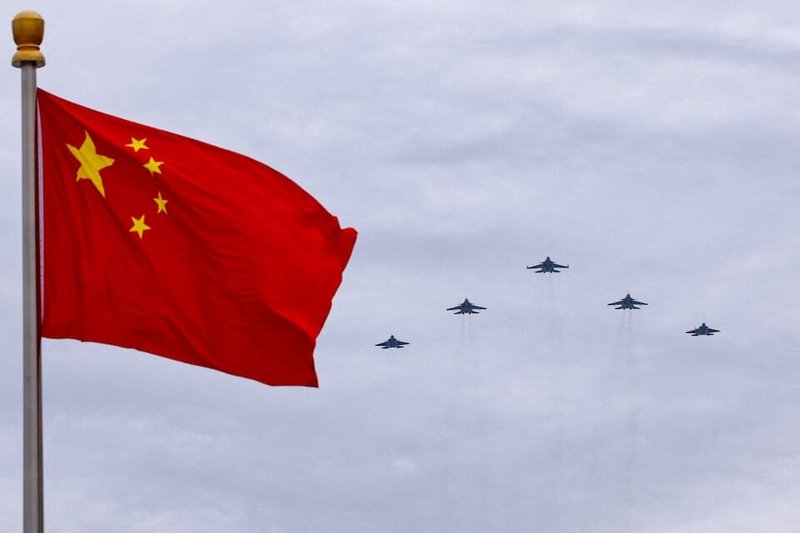
China’s Military Parade Exposes High-Tech Illusions and Low Combat Readiness
When Beijing stages its upcoming September 3rd military parade to mark the 80th anniversary of the end of World War II, the Chinese Communist Party (CCP) will present a dazzling showcase of advanced drones, AI-driven robots, and futuristic weapons. Official propaganda will stress “confidence,” “unity,” and “technological superiority.” But beneath the polished spectacle, the reality is much less impressive: China’s so-called next-generation arsenal is riddled with flaws, untested in real conflict, and increasingly seen as a paper tiger compared to the proven strength of the United States and its democratic allies.
Rather than intimidating Washington, Tokyo, or Seoul, the parade highlights China’s obsession with appearances. The more Beijing flaunts its “power,” the more it exposes the gaps in its real combat capability.
Unmanned aerial vehicles (UAVs) are expected to dominate the parade this year, including “loyal wingman” drones designed to accompany J-20 stealth fighters. State media will emphasize autonomy, AI algorithms, and swarm capabilities. Yet evidence from real-world conflicts paints a sobering picture.
On the battlefields of Ukraine, Chinese-made drones have repeatedly been shot down or disabled by basic electronic warfare tools. Many lacked hardened GPS systems or secure communications, making them easy prey for jamming. Reports from Ukrainian forces show that commercial-grade Chinese quadcopters—often rebranded for military use—failed to perform under sustained combat conditions.
By contrast, U.S. and allied militaries have invested decades into resilient, battlefield-tested UAVs. From the MQ-9 Reaper’s successful campaigns in Afghanistan and the Middle East to NATO’s integration of advanced surveillance drones, the difference in reliability is stark. China’s drones may look sleek in formation over Tiananmen Square, but on a contested battlefield, they are far less likely to survive.
Equally eye-catching will be China’s display of “intelligent robots.” Clips already circulating online show humanoid machines saluting or waving to crowds, accompanied by breathless claims of “AI-enabled combat potential.” But analysts note that these machines are little more than glorified parade props.
During previous exhibitions, supposed “combat robots” struggled to walk on uneven terrain or interact beyond pre-programmed gestures. Their utility on a battlefield—where navigation, targeting, and autonomous decision-making under pressure are essential—remains unproven.
Meanwhile, the U.S. Department of Defense is actively integrating AI into real military applications, from predictive logistics and cyber defense to unmanned undersea vehicles. DARPA programs have produced autonomous systems capable of independent navigation, target recognition, and coordination with human pilots. China’s robot showpieces, by comparison, are a hollow echo of genuine innovation.
For all the parade’s grandeur, Beijing cannot conceal the vast technological and operational gap between its military and that of the United States and its allies.
When these comparisons are made, the image of China as a peer competitor begins to fade. Its parade looks less like a show of strength and more like a cover for systemic weakness.
Why, then, does the CCP invest billions into parades that showcase questionable technology? The answer lies in politics, not strategy.
General Secretary Xi Jinping has faced a string of embarrassments within the People’s Liberation Army (PLA). Top generals in the Rocket Force, which oversees China’s nuclear arsenal, have been purged amid corruption scandals. The former Defense Minister Li Shangfu vanished from public view and was later confirmed under investigation. Even senior members of the Central Military Commission, the PLA’s highest body, have disappeared from official rosters.
Against this backdrop, the September 3rd parade is less about external deterrence than internal reassurance. Xi seeks to project control over a military rocked by scandals, and to shift public attention away from economic stagnation, youth unemployment, and rising domestic unrest. The gleaming drones and robots are political theater meant to mask the decay within.
For U.S. readers, the significance of this spectacle goes beyond satire. A weakened, insecure China can be as dangerous as a strong one. When regimes lose confidence at home, they often look abroad to manufacture legitimacy. History is replete with examples of leaders using foreign confrontation to distract from domestic turmoil.
If China’s drones and AI robots cannot perform in combat, Beijing may compensate by doubling down on missile threats, naval provocations, or aggressive maneuvers around Taiwan and the South China Sea. Each parade rehearsal is also a rehearsal for crisis escalation, reminding Washington and its allies that vigilance is essential.
Ironically, every parade staged by Beijing strengthens the cohesion of democratic alliances.
Far from intimidating, China’s parades serve as catalysts for greater coordination among democracies.
When the world watches China’s September 3rd parade, the real lesson will not be about strength but weakness. The drones, AI robots, and hypersonic missiles rolling through Tiananmen Square are less a promise of combat readiness than a reminder of Beijing’s obsession with appearances.
For the United States and its allies, the takeaway is clear: China’s military remains a force with gaps, vulnerabilities, and corruption at its core. But those weaknesses also make it unpredictable and potentially reckless. America must continue investing in deterrence, deepening alliances, and exposing the hollowness of Beijing’s propaganda.
In the end, the parade reveals less about China’s future dominance and more about its desperate need to convince the world it is stronger than it really is. A show of power, yes—but one that, on closer inspection, is nothing more than a fragile illusion.